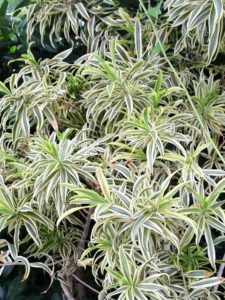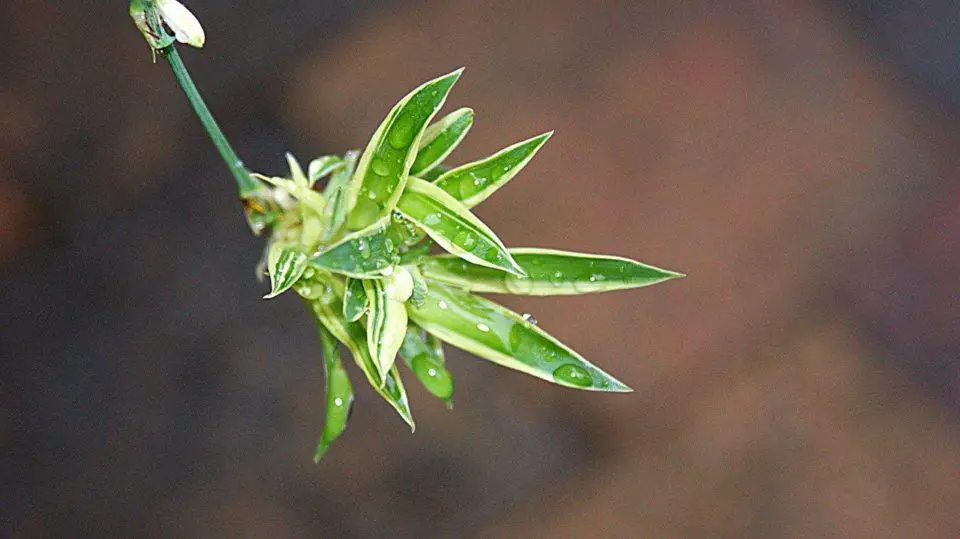Some links in the post are affiliate links and I get a commission from purchases made through some links found in the post.
Spider plants have beautiful long leaves with white or solid green variegated patterns.
They are an easy-to-grow plant and will look beautiful whether you plant them indoors or outdoors. Spider plants are not hard to take care of and will definitely add beauty to your surroundings.
Spider plants also produce flowers that are white in color. They grow on the stems and look just like spiders hence they are called spider plants.
Spider plants can sometimes suffer from root rot and therefore it is important to look at all the causes and how to save spider plants from root rot.
It is easy to get rid of root rot in spider plants and keep reading to know more about how to save your spider plant from root rot and what are the main causes of it!
Root rot in spider plants is down to too much watering or the soil not draining enough. This then causes there to be a lack of oxygen getting to the spider plant which in time can kill the plant.
It depends on the severity of the root rot if you can just allow the soil to dry, replace the soil or if it is too badly damaged needing to start with a new plant altogether.
What Are The Signs Of Spider Plant Root Rot
Root rot is common in spider plants. Usually, the signs of root rot start to appear when the damage is already done to a plant. Therefore, it is always better to look out for any signs of root rot in the spider plant.
We will look at some signs of spider plant root rot:
Brown or Mushy Roots
 Look carefully at the roots of your spider plant. If you see any type of brown or mushy roots then your plant might be suffering from root rot.
Look carefully at the roots of your spider plant. If you see any type of brown or mushy roots then your plant might be suffering from root rot.
The root is where all the problem starts so if you see any change in how the roots of your plant are looking then it might be time to take your plant out of the container and clean the root rot.
If your plant looks unhappy from the outside without any visible changes then root rot is the culprit for your unhappy plant!
Bad Odor From Roots
If you notice any different or unusual smell coming from your plant then it is a sign of root rot.
If the roots of your plants are affected they will give out a bad smell so look out for that if you want to know about the signs of root rot for your spider plant.
Slow Or stunted Growth
If you see that your spider plant has stunted or slow growth then this might be a sign of root rot. Look for any other reasons for the slow growth of your plant.
If you don’t find any other reason for the slow growth of your plant then root rot might be the main culprit behind the slow and stunted growth!
Wilted Leaves
Wilted leaves are another sign of your spider plant having root rot. If the leaves of your spider plant are wilted it means that there is a lack of nutrients in the roots which are causing wilted leaves.
The leaves of your spider plant will become unhealthy if left for too long.
Black Spots
If you see any black spots on your spider plant leaves then it means it might be suffering from root rot.
Any black spots on your spider plant are dangerous so it would be best to treat this problem as soon as possible to help your plant grow happily and healthily!
You may also like: 8 spider plant benefits
How To Save A Spider Plant From Root Rot
It is always a good idea to be on the safe side. Especially when it comes to plants you should always be extra careful. There are many ways you can prevent your spider plant from root rot.
If you want to save your spider plant from root rot then try to avoid these things for a striving and thriving spider plant:
- Over fertilization
- Overwatering,
- Low temperature,
- Humidity
- Pot with poor drainage
- Poorly drained soil
- Infected cuttings
- Using plastic pots
- Contaminated soil
If you keep a regular check on your spider plant you won’t face any big problems with your plant.
Being a little careful about how you treat your spider plant can benefit the plant in many ways in the long term.
Root rot is a common problem which you can avoid if you just keep a check on your plant and see how it’s growing.
If you find any changes in the way your plant is feeling or if your plant looks unhappy then it’s better to check for the signs of root rot!
Can A Spider Plant Recover From Root Rot?
 Yes. If you want to save your spider plant from root rot then you need to act quickly.
Yes. If you want to save your spider plant from root rot then you need to act quickly.
As soon as you see that your plant’s roots are not looking like themselves remove the plant from the pot and remove all the areas which are affected. The next thing you should do is to plant the spider plant in a new pot.
It is not difficult to get rid of the root rot in your spider plant. Just see for any mushy roots and remove them with a sharp knife or by putting them under the water and you can save your plant from root rot.
How To Trim Spider Plant Roots
If the leaves on your spider plants are yellow or look wilted then you need to trim the roots. We have given a step-by-step guide on how to trim the roots of your spider plant.
- You should use shears to cut off the leaves of your plant.
- Remove around 2.5 inches of the root so your plant can have more space when you plant it back in the pot.
- Don’t forget to add new soil to the pot.
- Also, keep it protected from direct sunlight so that your plant recovers fully from pruning.
- If your plant is root bound that means that your plant will not have any new place to grow and pruning is the only option left to let it grow.
Why Are My Spider Roots Above The Soil?
Spider plants have fast growth and therefore sometimes they tend to come out of the soil.
If the roots of your spider plants are above the soil it means they are pot bound. You should think about repotting the plant if you see the roots above the soil of your spider plant.
Keep a close eye on the growth of your spider roots and if you see the roots coming above the soil then you should repot the plant right away!
How To Repot A Spider Plant?
Repotting a spider plant is not that difficult and if you want to repot it then keeping reading to know more about how to do it!
- Remove the plant from its current pot.
- Rinse and trim its roots.
- Gently put it back in another pot.
- Make sure that your new pot has proper drainage holes.
- Spider plants will not tolerate wet soil for too long.
- First, put soil at the surface of the pot.
- Then put the plant on top of it.
- Next, put some more soil.
- Cover the entire plant with soil.
- Water your plant carefully and care like you usually do!
Tips On How To Grow Your Spider Plant
- Spider plants like even moisture.
- Make sure to plant your spider plant in a well-drained potting mix.
- Keep your spider plant in direct to moderate sun light.
- Spider plants don’t like direct sunlight because it can cause the leaves to turn brown or it might cause them to die.
- Make sure to re-pot your plant frequently because they have fast-growth and can become pot-bound quickly.
- You can grow a spider plant indoor or outdoor.
Care Tips
- Water your spider plant occasionally initially and once the plant is developed water it frequently.
- Don’t let the soil dry out too much.
- During summer and spring keep the soil moist. This will encourage growth.
- Try to keep your plants at average room temperature and humidity.
- Spider plants love moderate humidity and hence make a great indoor plant!
- Fertilize your spider once or twice a month. However, make sure not to over-fertilize your plant!
- If your spider plant’s leaves are turning brown scrape off the brown residue frequently.
- Avoid watering your spider plant with chlorinated water so try to water it with filtered water.
Final Thoughts
 Root rot in spider plants is common and nothing to be worried about. If you see any type of root rot in your spider plant it is better to start taking care of your plant even more.
Root rot in spider plants is common and nothing to be worried about. If you see any type of root rot in your spider plant it is better to start taking care of your plant even more.
Usually, the root rot occurs when the damage has been done to your plant but if you catch it in time then you will see that your plant might become its healthy self in no time!
Spider plants are easy to take care of the plant and are usually found in homes. You can plant it indoors or outdoors to add beauty to your landscape and it is also very pleasing to the eye!
If you are looking to start gardening or are a pro at it it is always a good idea to start your passion with a spider plant because all types of gardeners can take care of this easy plant.
It won’t just add beauty to your surroundings but it will also clean the air!

